Physical Address
304 North Cardinal St.
Dorchester Center, MA 02124
This chapter focuses principally on epithelial neoplasms of the vagina (soft tissue tumors are discussed in detail in Chapter 9 ). The most common lesions in the epithelial group are squamous, ranging from mild dysplasia to invasive squamous carcinomas. There is ongoing surveillance of women with in utero exposure to diethylstilbestrol (DES) for glandular lesions, ranging from adenosis to clear cell carcinoma.
The most important challenges faced by the pathologist are the classification of precursors, recognition of potentially serious lesions, including the exclusion of invasion, and recognition of rare entities that could cause diagnostic confusion or inappropriate management.
In the prior edition, vaginal intraepithelial neoplasia was placed under the squamous intraepithelial lesion terminology. Another term, vaginal intraepithelial lesion (VAIL), has also been used.
The recent Lower Anogenital Squamous Terminology Standardization (LAST) Project is now in line with this. Vaginal precursors fall into two categories—low-grade squamous intraepithelial lesions (LSILs) and high-grade squamous intraepithelial lesions (HSILs), as they do throughout the lower anogenital tract. The LAST consensus recommendations from the College of American Pathologists and American Society for Colposcopy and Cervical Pathology encourage this two-tiered approach throughout the lower anogenital tract (LAT) and standardization of the nomenclature used.
The main goal is to decrease interobserver variability and provide more useful clinical data. In the vagina, LSIL comprises exophytic condylomatous lesions as well as cytologically similar flat lesions. Similarly, HSIL encompasses vaginal intraepithelial neoplasia grades 2 and 3 (VAIN 2 and 3). Needless to say, despite the efforts to compress precursors into two distinct groups, many lesions will fall in the gray zone between the two, and the distinction between LSIL (VAIN 1) and HSIL (VAIN 2) will always be problematic. The reader can take some comfort from the fact that difficulty in separating VAIN 1 and VAIN 2 is universal although of very clinical significance.
A more recent reference with data from the U.S. Centers for Disease Control and Prevention's National Program of Cancer Registries and the National Cancer Institute's Surveillance, Epidemiology and End Results Program shows the incidence of vaginal carcinoma in situ in the United States to be approximately 0.1 cases per 100,000 women. The risk factors are identical to those for cervical and, to a lesser degree, vulvar intraepithelial lesions, specifically age at first intercourse and number of sexual partners, as well as conditions that compromise immune function. The risk of HSIL has been associated with the following:
Patients who have undergone a prior hysterectomy for HSIL of the cervix
Women who have had radiation therapy to the cervix or vagina
Women who have been taking immunosuppressive agents
Molecular studies have confirmed that human papillomavirus (HPV) is responsible for these lesions.
There are, however, some slight differences between SILs and similar lesions of the vulva and cervix, related to differences in the sites of origin and the HPV types involved. The vagina is similar to the cervix in that lesions analyzed from this area contain a wider range of HPV types than are seen in the vulva.
The vulva is a combination of skin and mucosa and is prone to infections by HPV types 6, 11, and 16. In contrast, the target epithelium in the cervix is the squamocolumnar junction and the area hosting the dynamic remodeling of epithelial phenotypes that characterizes the cervical transformation zone. The relative frequencies of LSIL and HSIL are similar to those in the cervix, approximately 3 : 1. Approximately 65% of women with VASILs have a concomitant or prior squamous intraepithelial lesion of the cervix.
A great majority of SILs regress spontaneously. The progression of LSIL to HSIL or cancer is extremely uncommon. Immunosuppressed women are also more likely to have persistent multifocal lesions. HSILs, those associated with high-risk HPV, and those associated with squamous intraepithelial lesions (SILs) in other anogenital sites are also more likely to recur and be multifocal.
An important variable in cancer risk is the age of the patient. The average patient with SIL is between 43 and 60 years of age. This is later than cervical precancers—10 to 20 years later—in one study.
About 5% of HSILs may progress to invasion, despite close follow-up. A recent study of the rate of progression to invasive vaginal cancer and the potential risk factors were evaluated in 205 women with biopsy-proven HSIL. Of these, 12 cases progressed to vaginal squamous cell cancer (5.8%), with a mean time interval from treatment to progression of 54.6 months (range, 4–146 months). The rate of progression was significantly higher in women diagnosed with VAIN 3 compared with those diagnosed with VAIN 2 (15.4% vs. 1.4%; p < 0.0001), which again speaks to a biologic overlap between VAIN 2 and condyloma. A lower risk of progression in VAIN 2 may warrant further subclassification of HSILs in certain clinical situations, such as younger patients. Women with HSIL who had a previous hysterectomy showed a significantly higher rate of progression to invasive vaginal cancer compared to patients who had not previously undergone a hysterectomy (16.7% vs. 1.4%; p < 0.0001). However, the risk is influenced by other cofactors, including age, lack of estrogen, prior irradiation, and vaginal trauma.
Vaginal inspection is a required component of the pelvic examination and usually entails rapid inspection of the mucosal surface following speculum placement. The indications for vaginal colposcopy are summarized in Box 12.1 .
An abnormal Papanicolaou (Pap) smear following hysterectomy
An abnormal Pap smear after apparently successful treatment of cervical neoplasia
Any Pap smear unexplained by cervical colposcopy or sampling of the endocervical canal
Any palpable or unexplained grossly visible vaginal lesion
All women with cervical, vulvar, or perianal, or anal human papillomavirus disease
Confirmed cervical neoplasia in an immunosuppressed patient
Monitoring all women with a history of in utero diethylstilbestrol exposure
Any woman with abnormal, unexplained, recalcitrant vaginal discharge or bleeding
Before cervical conization for noncorrelating cytology, histology, and colposcopic impression
The entire vagina needs to be closely examined because the appearance of the lesions can be subtle. Special attention should be given to the upper third of the vagina, where most disease is present. In DES-exposed women, glandular lesions are most common in the anterior upper third of the vagina.
Acetic acid and Lugol's solution can be used in colposcopic evaluation of the vagina. Acetic acid will highlight hyperkeratosis, which is often associated with LSILs, and can identify areas of punctation that may be associated with HSILs ( Fig. 12.1 ).
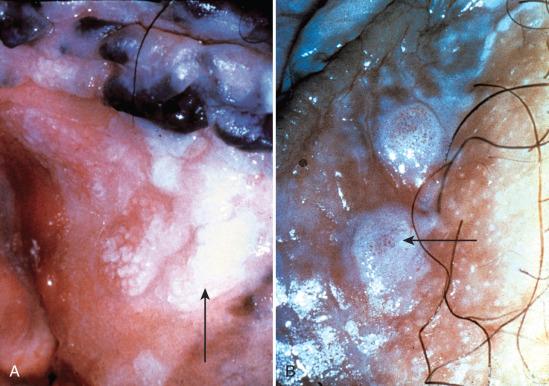
Lugol's solution should not be used in patients with an allergy to iodine. It stains glycogen-containing tissue a dark mahogany brown color, whereas nonglycogenated epithelium, specifically intraepithelial neoplasia, does not stain, typically appearing mustard yellow in color ( Fig. 12.2 ). HSIL, however, may appear simply as flat white epithelium. Thus, any potential lesion should be biopsied. Abnormal vascular patterns can be seen with colposcopy and are associated with HSIL. Well-developed vascular patterns of punctuation or mosaicism and atypical irregularly branched vessels are highly suspicious for invasive cancer. The chief limitation of the use of Lugol's solution is lack of specificity—that is, atrophic or inflammatory conditions of the vagina accompanied by immature squamous epithelium (and lacking glycogen), which will also not stain. Thus, the use of Lugol's solution is not as helpful for women with atrophy or inflammation of the vagina. The yield, however, can be improved considerably with a short course of intravaginal estrogen therapy, when clinically indicated, before colposcopy in postmenopausal women. Furthermore, perioperative use of intravaginal estrogen may directly facilitate healing after vaginal surgery.
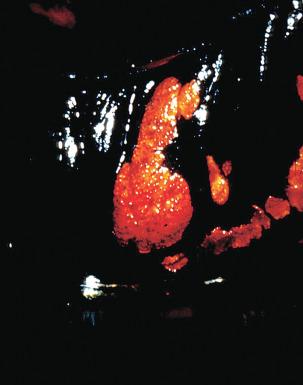
In the examination of DES-exposed women, adenosis appears as red granular tissue. Atypical vascular patterns are also often seen early in glandular lesions. If indurations or nodules are palpated, these should be sampled to rule out carcinoma, particularly clear cell carcinoma (CCA; see later in this chapter, “Clear Cell Carcinoma”).
Cytology specimens should be obtained from the cervix by cytobrush and spatula and four quadrants (circumference) of the upper third of the vagina (by spatula). All the specimens can be put in one container.
The lesions are similar to their counterparts in the cervix and fall into a spectrum ranging from LSIL, exophytic, or flat condyloma. HSIL corresponds to VAIN 2 or VAIN 3.
The first category of LSIL includes exophytic condylomas, which are commonly associated with HPV types 6 and 11. These lesions are discussed in Chapters 6 and 13 and consist of exophytic verrucopapillary lesions with superficial cell nuclear enlargement and koilocytotic atypia. They may be subtle histologically; the primary features will be increased nuclear density in the upper epithelial layers and mild anisokaryosis ( Fig. 12.3 ).
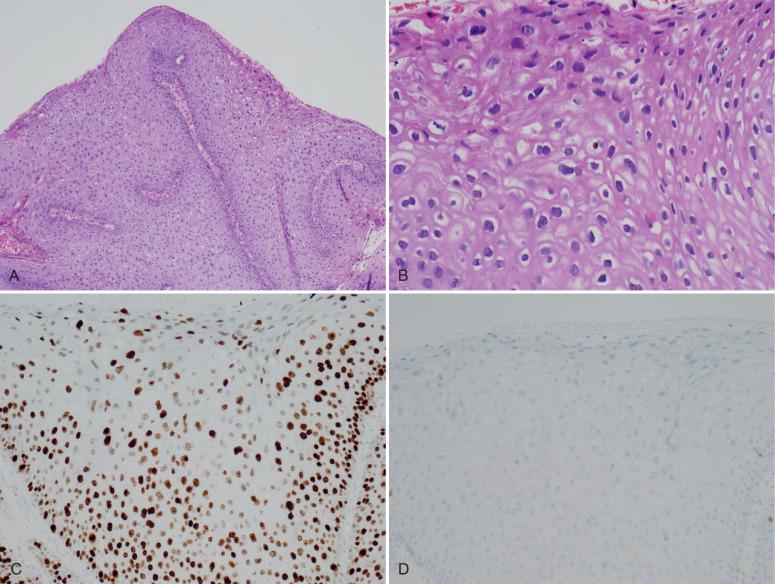
The second category is the flat condyloma, which has a similar distribution of cellular atypia but lacks the exophytic architecture ( Fig. 12.4 ). These may or may not be p16-positive, depending on the HPV present. Central to the diagnosis of LSIL is the absence of conspicuous nuclear atypia in the lower epithelial cell layers.
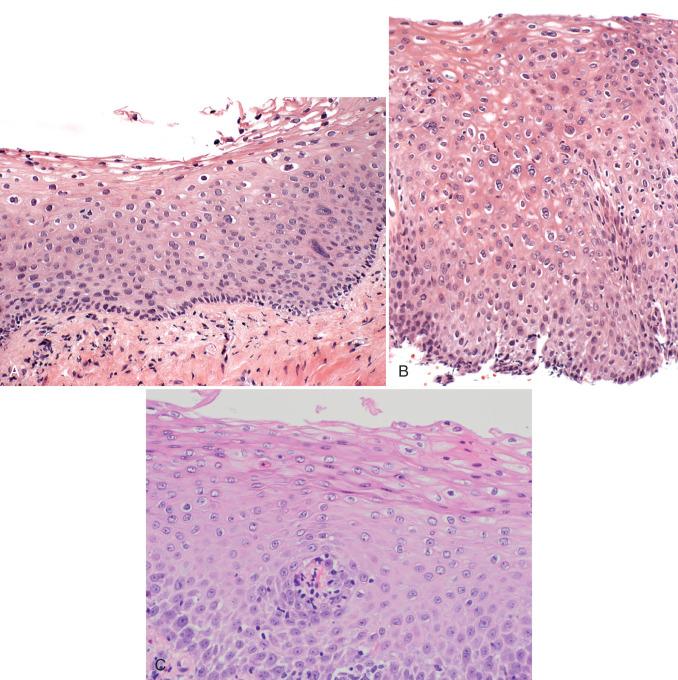
There are two benign entities most likely to be confused with LSIL. The first is nonspecific acanthotic and hyperkeratotic changes associated with prolapse ( Fig. 12.5A ). The other is small, fibroepithelium-l–like, polyp-like excrescences in the introitus of reproductive age women (see Chapter 11 ; see Fig. 12.5B ). Again, both of these lack cellular atypia and are no longer as likely to be as confused with HPV infections as they were in the 1980s. The diagnosis of low-grade abnormalities relies principally on morphologic criteria; immunostaining or HPV nucleic acid testing are not indicated. Exceptions are those cases in which sexual abuse is a critical variable that must be excluded.
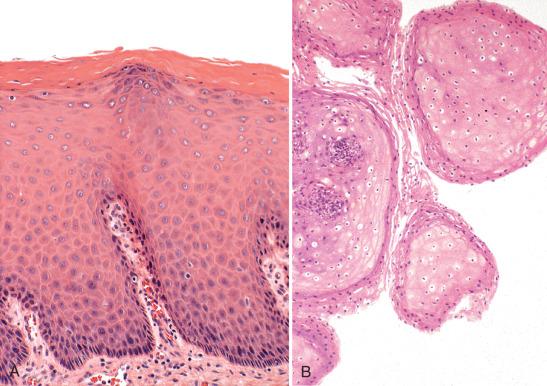
Some lesions might be confused with HSIL. One is a LSIL with some expansion of the immature cell layers ( Fig. 12.6 ). The pathologists should focus on the nuclear features, including chromatin complexity and distribution and nuclear overlap, while considering the overall pattern of growth, polarity, and differentiation. Tangential sectioning of LSIL might also cause some confusion ( Fig. 12.7 ).
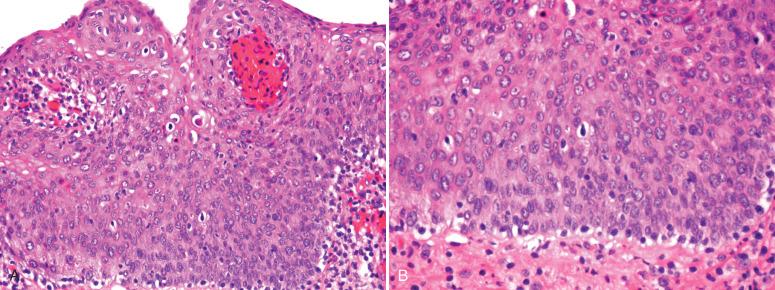
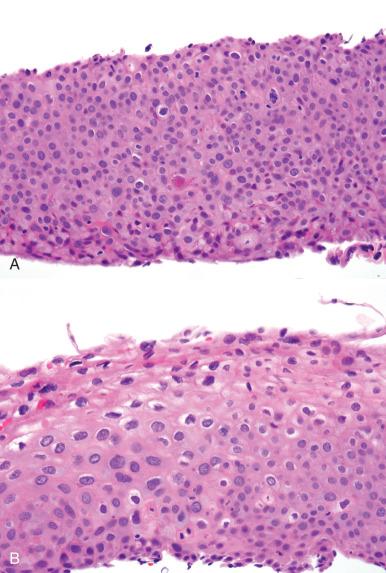
HSIL, similar to the cervix and vulva (see Chapters 6 and 13 ), displays full-thickness atypia ( Fig. 12.8 ). Lesions may be further subclassified, when clinically indicated, as VAIN 2 or VAIN 3. Care should be taken to recognize papillary architecture, which may be associated with a risk of concomitant invasion ( Fig. 12.9 ) .
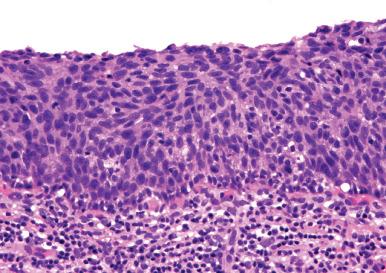
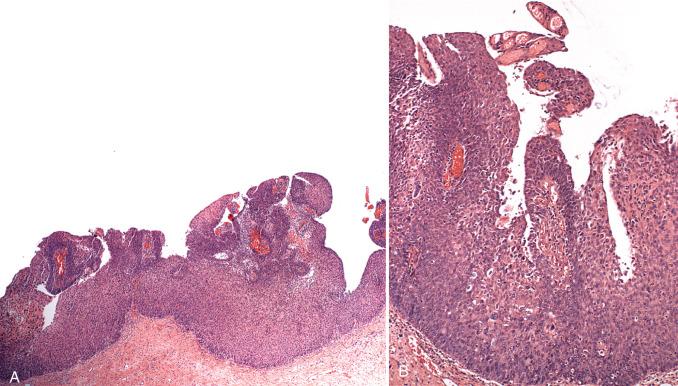
Mimics of HSIL in the vagina include atrophic changes and/or reactive, inflammatory, epithelial changes. Atrophy is associated with an increased nuclear-to-cytoplasm ratio and an increase in cell density due to closely opposed atrophic cell nuclei, which can mimic HSIL in biopsies as well ( Fig. 12.10 ). Inflammation might retard maturation and increase the number of epithelial layers with immature cells, raising a concern for HSIL ( Fig. 12.11 ).
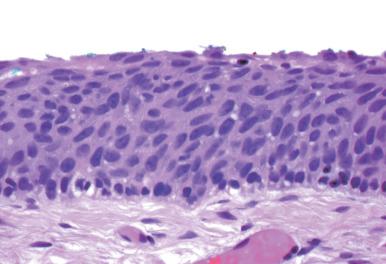
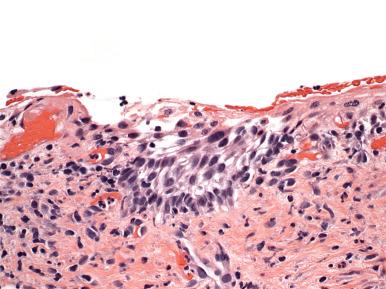
As noted in examination of the patient, if clinically indicated, a short 2-week course of vaginal estrogen improves colposcopic accuracy in postmenopausal patients with vaginal atrophy. In our experience, this helps the pathologic classification in that any reactive atypia due to atrophy can be significantly decreased or removed. Others have described significant decreases in cytologic atypia associated with intravaginal estrogen use, although much of this may represent treated atrophy-induced atypia.
To best guide patient management, the pathologist is encouraged to try to categorize the lesion as within a general LSIL or HSIL category. Understanding the threshold for high-grade atypias and being aware of mimics of HSIL are essential. However, it is our experience that many VASILs fall in a gray zone between LSIL and HSIL or SIL. The reader should feel free to classify a lesion as VASIL of uncertain or intermediate grade if unsure. This is preferable to forcing a diagnosis of HSIL when the atypia is not decisive, particularly in young women.
H&E morphologic evaluation remains the gold standard. Consulting with a second pathologist is known to improve accuracy, especially in a two-tiered grading system.
Become a Clinical Tree membership for Full access and enjoy Unlimited articles
If you are a member. Log in here